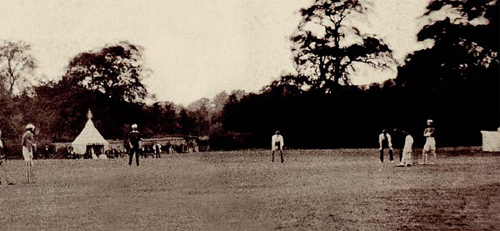


The teams posed for a photograph before the match. The blurred flag in the top right-hand corner of the photograph confirms that a relatively long exposure was necessary.

The small crowd of spectators who gathered for the match, with the scorer on the left of the picture. This was clearly as much a social occasion as it was a sporting one, with the ladies in their finery.
Almost certainly the first cricket match ever to be photographed, these pictures show the game which took place on 25 July 1857 at Hunsdonbury in Hertfordshire, the seat of E. L. P. Calvert, Esq, and was played between the Royal Artillery and Hunsdonbury Cricket Club.
Roger Fenton, one of the country’s leading photographers of the time (who had made his name as the semi-official photographer of the Crimean War), took at least five images of the match, using large-format wet collodion plates. Because of the low sensitivity of the process he was using, he needed the full cooperation of his subjects, who had to be carefully posed and who had to stand perfectly still for the duration of the exposure. Thus, no action shots were possible. He also needed a mobile darkroom with him, in which to coat and prepare his glass plates immediately before exposure, and then process them straight afterwards.
Writing twenty-five years later about cricket in London, Charles Dickens Jnr, a cricket fan himself, extolled the virtues of the Oval pitch, describing it as being ‘as nearly perfection as can be and, in seasonable weather a wicket can be selected as true as a billiard table.’ Less complimentary about Lords, he observed that it was ‘notoriously a difficult ground, but the Marylebone Club has recently expended a great deal of money in draining and relaying, and a great improvement is observable.’

To get such images, Fenton would have required the total cooperation both of the teams and of the spectators, as they would have had to stand still during an exposure that may have run into several seconds. The resulting prints were mounted on specially printed boards, which listed all the players in both teams. The fact that Fenton had arranged for special mounts to be printed suggests that quite substantial numbers of prints were made, yet, surprisingly, these images remain very rare.